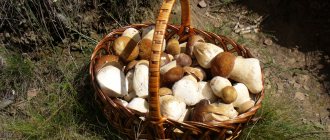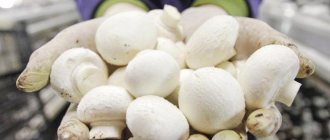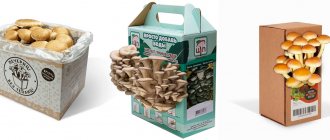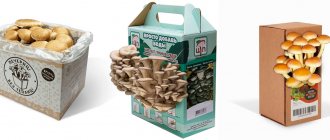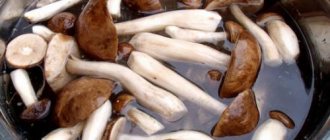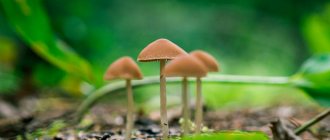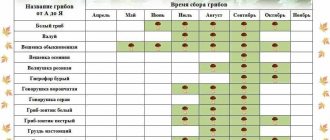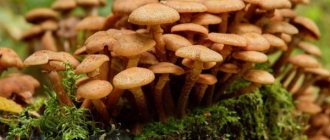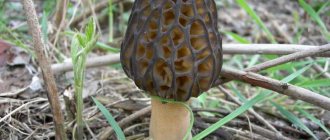Growing porcini mushrooms in a personal plot is not as adventurous a task as it might seem at first glance. The key to success is to recreate an environment similar to natural conditions.
In forests, boletus mushrooms prefer to grow under deciduous or coniferous trees, so owners of dachas with oak, birch, pine or spruce can count on a good harvest. However, if you make an effort and follow the advice of experts, porcini mushrooms can be grown even in a greenhouse or basement.
Conditions for growing mushrooms in the country
A mature boletus reaches large sizes: the diameter of the cap can reach 7-30, and sometimes 40 cm.
Strong, juicy and fleshy pulp is always light in color and does not darken during harvesting or cooking.
For this property, the porcini mushroom was given its official name. Boletuses are considered one of the most delicious and aromatic mushrooms, with a high content of natural protein and valuable vitamin and mineral composition.
In our latitudes you can find several varieties of porcini mushrooms. The name of each of them indicates in which places this species prefers to grow:
- pine;
- spruce;
- birch;
- oak;
- steppe;
- hog;
- spikelet.
Pine and birch porcini mushrooms are best suited for cultivation in the country, especially since the mycelium of these varieties is offered by online stores, nurseries and garden centers.
Growing porcini mushrooms at home will be successful if trees corresponding to the name of the mushroom variety grow on or near the garden plot.
In the wild, the mycelium of boletus mushrooms is always located in close proximity to the roots of trees and forms a mutually beneficial symbiosis, or mycorrhiza, with them.
Plants, with the help of mushrooms, obtain useful substances and minerals from the soil, and mushrooms from trees and cereals obtain plant sugars necessary for the development and growth of fruiting bodies.
The porcini mushroom prefers dry, well-drained soils, moderate humidity and temperature, short thunderstorms with showers, diffused or direct sunlight (it is one of the few varieties that tolerates exposure to sunlight well).
At home, two methods are used to harvest boletus mushrooms:
- Extensive. They grow mycelium in the nearest grove or on a summer cottage and take care of it.
- Intensive. They use special equipment and place it in separate rooms, greenhouses and basements. Imitate and maintain conditions similar to their natural habitat.
For owners of country houses and their own houses, the first method of cultivation is more suitable as the simplest and least expensive.
The second option for growing boletus mushrooms will be useful for those who intend to grow mushrooms not only for themselves, but also for sale.
How to grow a lot of porcini mushrooms on your site? Video:
How to grow a lot of porcini mushrooms on your plot (result)
Selecting a room
Mushrooms appear after rain - everyone knows this. This means that high humidity is the main condition. White ones grow under trees, i.e. they love thinned out light. Fog is ideal for the appearance of the fruiting body. It's difficult to recreate it on a windowsill.
You can only carefully maintain humidity by spraying drops of water in a fine dispersion. To prevent the room in which you dared to conduct the experiment from being ventilated, it should be carefully closed, avoiding drafts.
You will need large pots, since mulching the soil helps a lot to recreate the environment of porcini mushrooms. The mulch layer should be high; straw is suitable for it. But it is best to use containers in which indoor plants are already growing. You can try to organize a symbiosis of mushrooms with different types of decorative flowers.
Did you know? The mushroom is called porcini due to the color of its pulp, which does not change not only when cut, but also after drying.
However, all this does not guarantee success in growing porcini mushrooms, since they require the following conditions:
- Availability of a heating system, temperature control (up to +18°C).
- Air conditioning. Ventilation can dramatically change the temperature and relative humidity, and air conditioning allows you to ensure that the air is constantly fresh.
- Special lighting. The light should be daylight and diffused.
If such conditions can be created, then it is most convenient to use a system of shelving on which flowerpots, pots or containers can be placed.
Growing porcini mushrooms from mycelium
To plant porcini mushrooms, you need to acquire mycelium, from which a mycelium will eventually form.
The easiest way to purchase mycelium is in specialized or online stores.
Using a ready-made crop greatly simplifies the process of planting and care, so even a novice mushroom grower can handle it.
The optimal time for planting mycelium is from May to September, but experts recommend doing the work in August or September. Before starting planting work, you need to prepare:
- soil with a high peat content or pure peat;
- compost;
- fallen leaves;
- moss;
- small dry branches or fragments of tree bark.
The place chosen for planting must be prepared in advance:
- Next to a healthy and not very old tree, remove the top layer of soil (10-20 cm) with a shovel. The diameter of the bare area with a tree in the center should be 1-1.5 m.
- Spread a mixture of dry leaves, moss, bark, compost and peat over the entire surface of the bare soil in a layer of no more than 2 cm.
- Place pieces of mycelium in a checkerboard pattern on top, maintaining an interval of 25-30 cm between them. With this layout, a store-bought package is enough for one tree.
- Return the previously removed layer of soil to its place, covering the planted porcini mushroom mycelium.
- Water the area with a watering can or through a sprayer so as not to wash away the top layer of soil. To sufficiently moisten the ground under one tree, at least 30-50 liters of water will be required, depending on the diameter of the plot.
- To reduce moisture evaporation and maintain soil moisture, cover the area with the future mycelium with a layer of straw (20-40 cm). The soil should not dry out, otherwise the mycelium may not take root.
Further care of the plot does not require much effort: the area should be watered regularly so that the soil does not have time to dry out.
The mycelium will form faster and will please the boletus mushrooms with a harvest next year if preparations with effective microorganisms are regularly added to the water for irrigation (Baikal EM-1, Siyanie-1, Siyanie-2, EM, EM-ceramics, Bokashi).
Advice! Porcini mushrooms can also be grown in dry areas if, before planting the mycelium, hydrogel granules are added to the soil at a rate of at least 3 g per square meter of area.
How to grow a lot of porcini mushrooms on your plot (October)
Reviews and comments
- Ekaterina bought porcini mushroom mycelium, did everything according to the instructions, watered it for a whole year, but there were no mushrooms. none of this is true. At the dacha, porcini mushrooms cannot grow under artificial conditions.
Anatoly I’ll try to grow porcini mushrooms, the devil knows. It’s a little difficult, it didn’t work out the first time. Can bring soil from the forest where porcini mushrooms grow. However, you may be subject to penalties. One mushroom - 65 hryvnia - in 2022. The times of 1928-1930 are coming. The rulers have hammered home the old days. Horror. Nothing good will happen to the future generation, which is a pity. What our grandfathers and fathers fought for. He can declare war on the good guys and within an hour they will be captured. That would be great.
How to prepare mycelium with your own hands?
To grow boletus mushrooms in the country, it is not necessary to spend money and specially purchase porcini mushroom mycelium. You can prepare planting material yourself, but to do this you will have to go into the forest and collect large, mature fruiting bodies with a cap diameter of at least 10-20 cm.
It’s not scary if the forest products are infected with insect larvae - this will not affect the survival rate of the mycelium in any way.
When harvesting, you need to choose mushrooms that grow under the same trees that are located in or near the dacha. So, if there is a birch tree in the garden plot, then in the forest you should look for boletus growing under the birch tree. If the dacha is located next to a pine tree, you need to find porcini mushrooms growing near the roots of the wild pine.
DIY recipe for making “seedlings”:
- Mash the mushroom caps with your hands or pass through a meat grinder to make a paste. For 10 liters of solution, use at least 10-15 mature boletus mushrooms.
- Pour rain or soft water into a small bucket, passed through a household filter or reverse osmosis system. Chlorinated tap water cannot be used.
- Dissolve potassium permanganate crystals in water so that the liquid acquires a light pink color, and granulated sugar at the rate of 50 g per 10 liters of water.
- Add mushroom pulp, stir and leave for a day.
- The next day, strain the “sourdough” through double-layer gauze or a fine sieve. Use the mushroom substance remaining in the gauze as planting material. Do not discard the strained liquid. It contains spores of porcini mushrooms and is useful for sowing.
Important! Collected mushrooms should be processed as soon as possible - no more than 10 hours should pass from the time of collection to soaking.
You cannot freeze collected mushrooms or place them in the refrigerator, otherwise it is unlikely that you will be able to grow anything from them.
The technology for planting in this case will be slightly different from that where ready-made store-bought mycelium is used, so it should be considered separately:
- Prepare the planting site as described above.
- Pour the strained solution with boletus spores onto the bare roots of the tree, distributing it evenly over the entire surface of the area. For better survival, you will need at least 2 liters of liquid per 1 square meter. m.
- Place fragments of the mushroom substance remaining after straining on the moistened soil in a checkerboard pattern.
- Return the removed layer of soil to its place and carefully water the “bed” from a watering can.
Further care of a mushroom plot sown with both store-bought and homemade mycelium is the same.
How to grow a lot of porcini mushrooms on your plot (August)
Reproduction by spores
When there is already a harvest, you can propagate the crop. They do this as follows:
- One large fruit should be left in the garden so that it becomes overripe.
- Then its cap, which contains the spores, is crushed, removing the skin.
- The mass is placed in a container (a 1 liter jar is possible), 5 g of sugar, 20 g of yeast are added and clean, preferably spring water is added.
- The mixture should stand for 2 weeks in a warm place.
- After this, 150 ml of mushroom infusion is brought to a volume of 10 liters with clean water and the selected area of soil is spilled.
- Then regular watering is carried out so that the moisture, seeping deep, pulls the spore material with it.
Caring for a mushroom plot
Even under favorable conditions, the mycelium takes about a year to take root, so you can’t count on a harvest during the sowing season. In many cases, even in the second year after planting, it is not possible to find at least one boletus on the site.
But this does not mean that the experiment in growing mushrooms at the dacha was not a success: a mycelium is formed in the ground, which sooner or later will delight you with pot-bellied mushrooms.
All this time it is necessary to maintain the appropriate temperature and soil moisture:
- Once a week, water the ground around the tree at the rate of 40-50 liters of water per tree. In hot and dry periods, increase the number of waterings, in cool and rainy periods - reduce. The next watering should be carried out after the top layer of soil has dried.
- Water the mycelium through an irrigation system or from a watering can, periodically adding preparations with effective microorganisms to the water.
- In the winter, mulch the mushroom plot with a layer of straw, hay, leaf litter or spruce branches, and remove the cover in the spring.
It will be possible to collect mushrooms from one plot for at least 3-5 years in a row, and when using EM preparations, this period will increase to 7 years. When the mycelium ages and stops producing crops, it can be renewed - planting new mycelium using one of the methods described above.
Advice! When picking mushrooms in the forest, you can dig up a small piece of soil with boletus mushrooms (one or several) and dig it under the same tree in your dacha. Over time, the mycelium will grow and delight you with forest gifts.
A method of growing mushrooms on your own plot. Video:
Part 2. HOW TO GROW MUSHROOMS IN LARGE QUANTITIES ON YOUR PLANT
Champignon
These mushrooms require virtually no sunlight to germinate. They are also undemanding, like oyster mushrooms, and can even grow near fruit trees. An important condition for growing champignons is the use of soil rich in organic components.
To prepare the soil mixture, you need to prepare 12 kg of gypsum and lime, 50 kg of cow or horse manure, 20 kg of straw. The ingredients are thoroughly mixed to form a pile. It is watered with water and compacted tightly. The mixture is covered with plastic wrap, leaving it for 2-3 weeks. The ammonia smell should completely disappear.
Now you need to dig a trench 30 cm deep. It is filled with the prepared substrate. The soil is watered with plenty of water. The mycelium is placed in a trench. It is covered with straw. The ambient temperature should be around 20°C.
The soil on which the mycelium grows is moistened, but not compacted. The harvest can be harvested in just 2 months.
Growing porcini mushrooms in a greenhouse
Intensive technology for growing boletus mushrooms also has a right to life.
Anyone can try their hand at this, but first you will have to prepare a greenhouse and create a special microclimate with an air humidity of 80-90%.
The growing area must be well ventilated, since active growth of fruiting bodies is impossible without a constant flow of oxygen.
Growing porcini mushrooms in a greenhouse all year round will be successful if you use Dutch mycelium for sowing, sold through online stores or specialized retail outlets.
Breeders from Holland have developed a special variety of boletus that can easily reproduce in captivity. This variety can be grown in any premises (sheds, garages, basements, hangars) provided that an optimal microclimate similar to natural is created.
Important! From self-prepared “seedlings” in a greenhouse or basement, it is unlikely that you will be able to get at least one boletus, because without symbiosis with the roots of trees, the mycelium cannot exist.
The technology for planting boletus mushrooms in the country and in the greenhouse is the same:
- Dig holes, holes or grooves 20-30 cm deep.
- Line the bottom of the dug holes with a mixture of bark, leaf litter, twigs, moss, sawdust, compost and peat.
- Spread the mycelium, sprinkle with soil substrate and water.
Further care comes down to regular watering through a spray bottle or fine-drip irrigation system, maintaining favorable temperature conditions and humidity.
By the way, look at the previous article. There is a lot of useful information for you - How to grow champignons at home?
During the incubation period, the temperature in the greenhouse should be maintained within +23...+25°C, and with the appearance of the first caps, it should be lowered to +8...+15°C.
Landing
If everything is ready, you can start sowing. Place drainage in your pots in advance. Distribute the substrate over them (or other containers of your choice). The height of the layer is up to 35 cm. Leave some of the soil.
Now pour the prepared spore mixture evenly. Sprinkle a couple of centimeters on top with the same soil for germination. Some information can be gleaned from the packaging of the finished mycelium.
Important! Boletus contains natural antibiotics and helps fight harmful intestinal bacteria.
Typically the soil requirements are:
- leaves, grass, bark - the first layer is 3 cm thick;
- good soil or humus (the thickness is the same);
- the third layer is already mycelium;
- repeating the first layer, but a little thicker;
- soil from the beds - up to 5 cm.
Watering of such soil is by drip, immediately after sowing. Moisturizing should only be done to prevent drying.
Breeding boletus in the basement
In basements or garages, boxes filled with nutritious soil and installed on multi-tiered racks can be used for planting boletus mushrooms.
Experienced mushroom growers recommend adding buckwheat or sunflower husks, hay, deciduous or pine sawdust, and chopped corn cobs to the soil mixture.
The period of formation of the mycelium takes place in complete darkness, but with the appearance of the first small mushrooms you will have to take care of additional lighting.
It can be either natural or artificial: fluorescent lamps or more economical LED lamps are best suited. The total daylight hours should be 5 hours or more.
A few words about the harvest
The following rules should be observed: do not cut the mushroom with a knife, but carefully twist it, trying not to damage the mycelium; the depressions left after harvesting should be filled with soil.
If you follow these simple rules, you can quite realistically collect up to twenty kilograms of mushrooms from one square meter.
In Russia, only a few are engaged in growing boletus mushrooms, since at the initial stage this type of activity requires serious financial investments. To justify your investment and start making a profit, you need to be patient.
Experienced entrepreneurs advise obtaining all the necessary documents, and only after that purchasing equipment, and starting with small areas.
Choosing a site
Considering that boletus is a forest mushroom that grows in close symbiosis with perennial trees and other plants, you need to try to create optimal conditions for it:
- surroundings - oak, birch (their age is 50 or more years), spruce, pine (25 and older);
- other representatives of the green world - moss, lichen;
- neighboring mushrooms - greenfinch, russula, chanterelle;
- soil – loamy, sandy loam or well-drained sand or sandy loam;
- temperature - above 8°C and until frost, optimal 15-18°C;
- special conditions – thunderstorms, fog, heavy dew;
- illumination - loves light, but also grows in partial shade.
If you have the opportunity to choose a place that is suitable in all respects, then you can safely prepare your own planting material. Some people try to plant prepared spores simply on the site, but such attempts are rarely crowned with success.
Planting material
You can purchase mushroom mycelium at places where gardening supplies are sold (in a store, at a fair) or you can independently obtain spores (or part of the mycelium) from wild champignons.
Store assortment
Seed, "Aelita", "Prestige", etc.) offer champignon mycelium in small packages
When purchasing, pay attention to the expiration dates, and store the package unopened in a dry and cool place, possibly in the refrigerator (but not in the freezer)
Two-spore champignon (white)
The most common champignon, familiar to us, highly productive and very tasty.
Royal champignon (brown)
This is a special species with a light brown cap. It has an intense aroma and richer taste. Gourmets believe that in terms of taste it is close to porcini mushrooms.
Brazilian champignon (brown medicinal)
It is believed that this type of champignon, with a scaly brown cap, has unique healing properties: normalizes the functioning of the liver, kidneys and gastrointestinal tract, restores immunity after exposure to strong drugs; It’s as if he’s even fighting cancer.
INTERESTING!
There are also other edible types of champignons with their own external characteristics and shades of taste.
Disputes from wild plants
In our natural conditions, white champignon (bisporous) is found everywhere, and obtaining its planting material is not difficult.
You can get spores for reproduction. To do this, the caps of overgrown, old champignons are filled with natural water (rain, river or spring) and left for a couple of days. The resulting mixture is used to water the prepared bed.
Live mycelium (mycelium) is also used. In the place where the mushrooms grow directly, after the rain, pieces of soil the size of a matchbox are cut out. They serve as planting material.
Option number 1: buy a ready-made block
In our country, the industrial production of mushrooms is well developed: in equipped insulated hangars, a rich harvest of champignons, oyster mushrooms and shiitakes is obtained. Champignons are grown on compost (straw and chicken droppings), and oyster mushrooms and shiitake are grown in bags (blocks) filled with straw, sunflower husks or other substrate. The mycelium (mycelium) is placed in compost or straw, and mushrooms emerge from it. Automated production maintains the microclimate: temperature and humidity. Some enterprises take only the first harvest from the bags and then sell them to summer residents. Small wholesale starts from 1 kg of mycelium. Article on the topic For mushrooms. Are there any benefits from the gifts of the forest?
